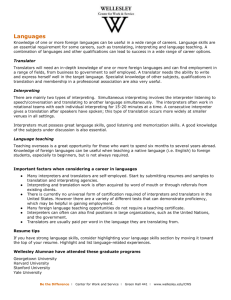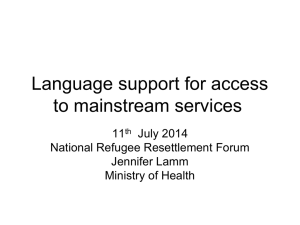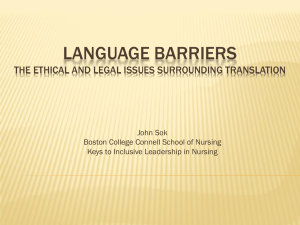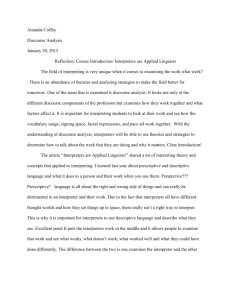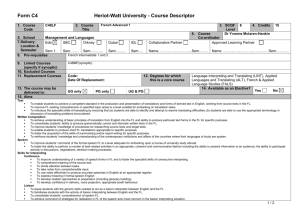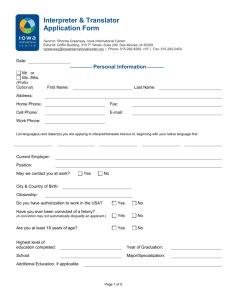Translating and Interpreting Sector Roundtable Discussions – Public
advertisement
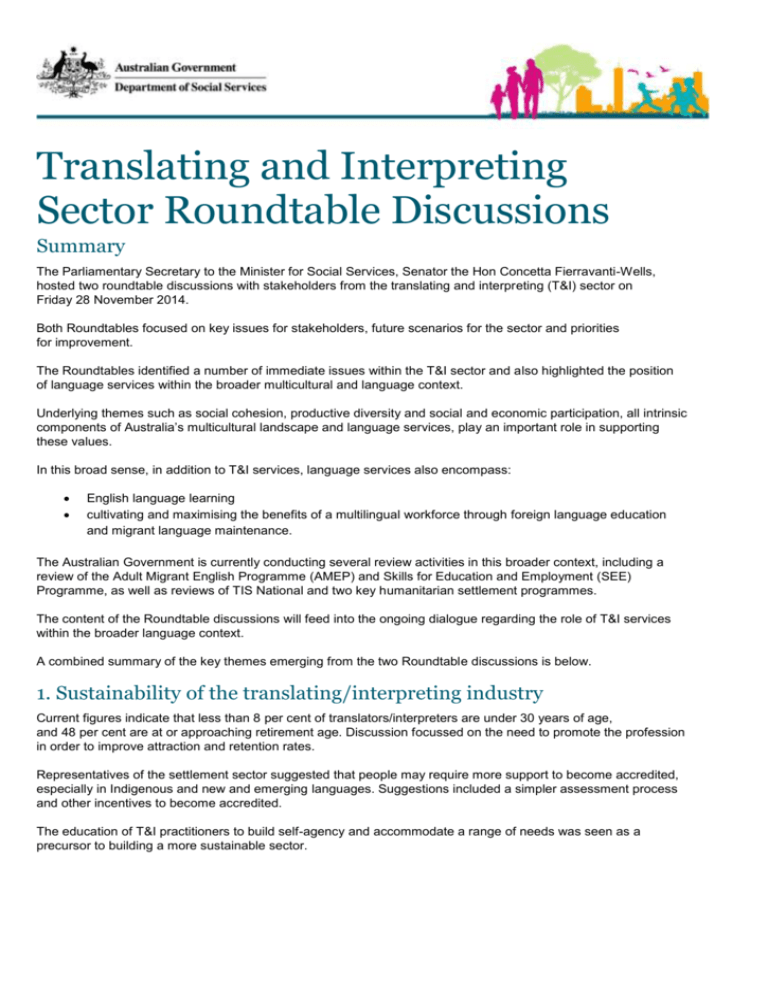
Translating and Interpreting Sector Roundtable Discussions Summary The Parliamentary Secretary to the Minister for Social Services, Senator the Hon Concetta Fierravanti-Wells, hosted two roundtable discussions with stakeholders from the translating and interpreting (T&I) sector on Friday 28 November 2014. Both Roundtables focused on key issues for stakeholders, future scenarios for the sector and priorities for improvement. The Roundtables identified a number of immediate issues within the T&I sector and also highlighted the position of language services within the broader multicultural and language context. Underlying themes such as social cohesion, productive diversity and social and economic participation, all intrinsic components of Australia’s multicultural landscape and language services, play an important role in supporting these values. In this broad sense, in addition to T&I services, language services also encompass: English language learning cultivating and maximising the benefits of a multilingual workforce through foreign language education and migrant language maintenance. The Australian Government is currently conducting several review activities in this broader context, including a review of the Adult Migrant English Programme (AMEP) and Skills for Education and Employment (SEE) Programme, as well as reviews of TIS National and two key humanitarian settlement programmes. The content of the Roundtable discussions will feed into the ongoing dialogue regarding the role of T&I services within the broader language context. A combined summary of the key themes emerging from the two Roundtable discussions is below. 1. Sustainability of the translating/interpreting industry Current figures indicate that less than 8 per cent of translators/interpreters are under 30 years of age, and 48 per cent are at or approaching retirement age. Discussion focussed on the need to promote the profession in order to improve attraction and retention rates. Representatives of the settlement sector suggested that people may require more support to become accredited, especially in Indigenous and new and emerging languages. Suggestions included a simpler assessment process and other incentives to become accredited. The education of T&I practitioners to build self-agency and accommodate a range of needs was seen as a precursor to building a more sustainable sector. Translating and Interpreting Sector Roundtable Discussion – Summary 2. Training and development for translators/interpreters A number of participants were of the view that greater on-the-job support would improve service delivery and increase retention rates as well. The practitioners in attendance generally agreed that opportunities for mentoring, debriefing and feedback mechanisms would be highly valuable, especially for practitioners engaged in work of a stressful and/or challenging nature. Additional training in the areas of ethics, privacy and business skills was also suggested. It was noted that a number of practitioners are self-employed but do not necessarily have sufficient knowledge or skills for running a business. Recognition of prior learning and more flexible training delivery options were put forward as areas for improvement. A number of stakeholders suggested that better incentives for practitioners to attend training and maintain their skill level would have a positive impact on their capacity and currency of skills. The sector recognised the value of continued open communication and capitalising on networking opportunities to learn from each other. 3. Career pathways Settlement sector representatives and associated peak bodies advocated for greater encouragement of volunteers and bilingual workers to gain accreditation in translating/interpreting, especially speakers of new and emerging languages. This could take the form of interpreting credentials, or bilingual worker credentials, if that suggested option is progressed. It was suggested that more flexible training options and career pathways may be one way of attracting these people into the profession. 4. Quality of translating/interpreting services There was general agreement that national certification of all languages would not be feasible for new and emerging languages without the “critical mass” required to make training and testing in those languages a viable option. A number of stakeholders were of the view that good quality services means more than ‘services provided by an accredited professional’. For example, sensitivity to the client’s circumstances were equally important in providing a quality service. There was general agreement that the sector would benefit from greater support in assisting practitioners to specialise in particular fields (e.g. domestic violence, medical or legal settings). Strengthening mechanisms for managing unprofessional conduct and increased accountability for interpreters were also identified as areas for development. 5. Procurement of translating/interpreting services As government is the largest consumer of translating and interpreting services, discussion focussed on compliance with government policies underpinning language service provision. Translating and interpreting companies suggested that an improved shared understanding between government departments of minimum benchmarks relating to quality, accreditation and fees may prevent organisations ‘bidding to the bottom’ in an attempt to quote the lowest possible price, while not necessarily providing the highest quality services. Some suggested that purchasers of T&I services should first have a good understanding of the target audience and their needs, so that targeted and tailored services can be delivered, thereby maximising the use of resources and the quality of T&I services. Various stakeholders noted that Australians collectively possess a vast array of language skills, making our language services a potential export commodity. Sector representatives considered this issue and agreed this could be a potential export industry. The need for broader reform to the current market model was also discussed, however no preferred model was presented or agreed upon. 2 Translating and Interpreting Sector Roundtable Discussion – Summary 6. Access to interpreters Settlement sector representatives and associated peak bodies outlined a lack of access to interpreters in rural and regional areas, and suggested that bilingual/bicultural employees may have a role to play in addressing this issue. A representative of the deaf community advocated for Auslan to be recognised as a culturally and linguistically diverse (CALD) language. It was also explained that all deaf Auslan users learn Auslan as their first language, and for some, Auslan might be their only language. Therefore they agreed it is imperative that the use of Auslan interpreters be considered as part of regular service delivery. 7. Technology and innovation A number of language service providers were in favour of using ‘technology as an enabler’, particularly Skype and videoconferencing facilities to improve access to interpreters in regional and rural areas. The translating and interpreting sector encouraged the government sector to consider leading the way in enabling access to information. Suggestions included better, more accessible websites/electronic records, and the use of YouTube to improve communication with Auslan users. The use of YouTube could also benefit those who cannot read in their first language. One innovative proposal was the notion of ‘national release’ for interpreters. This would allow qualified interpreters to be ‘released’ from their day job to perform interpreting duties, in a similar way to volunteers being released for Army Reserve duties. The establishment of electronic records for storing translated data was also identified as a way to avoid duplication and make more efficient use of resources. 8. Value of language services There was a strong view amongst translators and interpreters that their line of work is generally undervalued and under-appreciated by users of T&I services as well as the broader community. It was observed that the Australian community needs to play a role in this, and a greater focus on language teaching/learning would be helpful. An appreciation and celebration of heritage and culture, bilingualism, multilingualism and foreign language ability, especially for young people, would also be of benefit. A number of practitioners raised the point that improved remuneration and conditions may help to increase respect for the profession. It was also suggested that the translating and interpreting sector could do more to identify opportunities to “sell” language services to the private sector. Government representatives noted that the T&I sector has a role to play in setting standards and promoting the value and professionalism of the sector. Another suggestion was that conducting a cost benefit analysis that demonstrates the economic risk of not using language services would be a useful resource for the sector. Related to this point is the need for more education among professionals (e.g. doctors and lawyers) to understand the risks to themselves/their business of not using interpreters. 9. Accreditation and benchmarking of services Government representatives suggested that there might be value in increasing the range of levels of classification/accreditation for translators and interpreters. For example, it was suggested that a non-professional interpreter may be adequate in a number of social settings (e.g. shopping, daily activities) however some settings always called for a trained professional (e.g. medical/legal appointments). A ‘bilingual worker’ credential or classification was also suggested as part of this model. 3 Translating and Interpreting Sector Roundtable Discussion – Summary There was general agreement that there is room for improvement in the current accreditation system, and NAATI’s Improving NAATI Testing (INT) project was acknowledged as a positive step towards that goal. Some suggested consideration could also be given to reviewing the Skilled Occupation List 1 and the role that it plays (i.e. pathway for entry into Australia versus career opportunity). Discussion also touched on the skills and breadth of services delivered by translators and interpreters. There is currently no shared understanding of what level of services can be delivered by whom, and it was suggested that such a benchmark might be a helpful point of reference. 10. Targeted service provision Settlement sector representatives suggested the sector was well placed to provide advice to government about migrant/refugee target groups and help identify any gaps in language services. Some participants also suggested that a shared understanding amongst purchasers of language services, of price rates and the scope of services included in language service tenders, would assist in streamlining the process and optimising value for money. It was generally agreed that an improved evidence base is required to inform any current or future supply-demand trends/gaps. This would allow for a greater understanding of complexities and a more targeted approach to making improvements. 11. Continued dialogue amongst the translating and interpreting sector It was generally agreed that continued dialogue amongst the sector was required to consider key issues and opportunities. An online forum was put forward as a possible way of continuing the conversation. Advocates encouraged those present, and practitioners in general, to join industry peak bodies to ensure representation. ………………………………………………….. The Parliamentary Secretary’s Office and the Department of Social Services wishes to thank all participants for your valuable input. 1 The Skilled Occupation List is compiled by the Department of Immigration and Border Protection. Candidates applying for an Independent or Family Sponsored Points Tested visa must nominate an occupation from this list. 4
